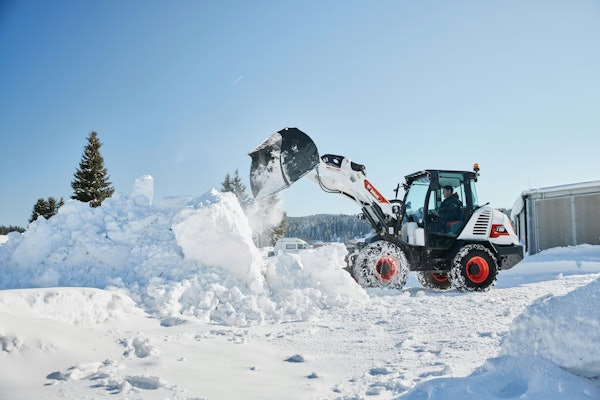It is tempting to view compact wheel loaders as specialty machines since they excel in load-and-carry applications in confined workspaces.
Like larger wheel loaders, compact wheel loaders feature a mid-machine articulating hinge pin, four equal size rubber tires, a rear-mounted engine, specialized loader geometry and a high-placed cab from which operators can monitor every aspect of the machine’s movement and operation.
Many machines employ four-wheel steer, which further enhances their maneuverability.
Because of these characteristics, they are typically used for cleanup, digging and moving material on jobsites with a restricted work area. They’re also great for landscape projects, where damage to existing landscapes or jobsites must be kept to a minimum. “These tire options combined with modern traction control systems provide tremendous traction when needed, or excellent flotation on sensitive surfaces,” says Keith Rohrbacker, product manager, Kubota Tractor. “So they are excellent machines for sensitive turf applications.”
“Compact wheel loaders can be immediately productive,” adds Brian Rabe, product manager, Gehl. “That’s because compact backhoes offer simple car-style controls with a gas pedal, brake pedal and steering wheel which are very familiar to even the most inexperienced operator and make them productive.”
But it’s wrong to assume compact wheel loaders are one-trick ponies only adept at loading trucks. Contractors and OEMs today understand that running a successful construction business requires flexible machines able to adapt to a wide array of job requirements. Compact wheel loaders meet this demand by employing high-capacity hydraulic systems and boom-mounted quick couplers, which allow the use of a wide array of attachments.
Indeed, you need to spend a great deal of time considering what attachments you will use with the machine if you’re in the market for a compact wheel loader, says Rabe. Typical attachments include heavy-duty buckets, light material buckets, side dump buckets, grapples and grapple buckets, pallet forks, snow plows, tree re-planters and work platforms. “Universal skid-steer attachment plates are also purchased frequently,” Rabe says. “These adapter plates are popular among customers who are transitioning from a skid steer to a compact wheel loader because it allows them to use attachments they already have.”
As compact wheel loaders grow in popularity, new takes on the basic machine configuration are coming on the market. One example is four-wheel, steerable axles. “Gehl all-wheel-steer loaders use a rigid-frame design in conjunction with two steerable axles that provide a strong and maintenance-free lift platform,” Rabe explains. “This design allows the machine to maintain the same lift capacity in the straight position or the fully turned position. We feel this is a huge advantage over articulated machines because any articulating unit loses lift capacity when turning, which results in less machine traction and less machine stability, creating a higher potential safety risk.”
Unique combination of features
There are, of course, many effective types of compact equipment available to contractors today. This can make deciding upon one machine type a daunting task. In most cases, says Bill Parker, product manager, Terex, a cold, hard look at applications is what brings many contractors to add compact wheel loaders to their equipment fleets. “Compact wheel loaders are capable of moving larger, heavier loads than competitive equipment types,” he explains. “In addition, they’re able to perform this work at distances and volumes large enough to warrant a step up in size from a skid steer or compact track loader.”
“Compact wheel loaders don’t damage sensitive surfaces the way a skid steer can because of their articulated steering systems,” adds Matt Mumford, product manager, compact wheel loaders, Caterpillar. “Compact wheel loaders also have generally lower ownership and operation costs than skid steers due to less tire wear and better fuel economy. Visibility to the sides and rear of the machine is better as is entry and exit from the operator’s station. You also benefit from higher breakout forces and lift capacities, and a smoother ride due to a wheel loader’s axle oscillation characteristics.”
Compact wheel loaders also compete with compact backhoe loaders for contractor dollars. Like skid steers, compact backhoes offer contractors a high degree of mobility and flexibility for a wide array of applications. “Compact wheel loaders are more maneuverable than backhoes and offer higher lift heights for loading trucks,” Parker says. “And they can handle heavier lift capacities than a compact backhoe.”
As always, the best way to determine if a compact wheel loader is the right size for your applications and business is to work with your local dealer, Mumford says. “Dealers have the expertise to best match the correct size machine to your job,” he says. “And once you determine the correct size machine for your job, your dealer can often provide you a rental machine or demo prior to making the purchase, further demonstrating a machine’s usefulness before you commit.”









